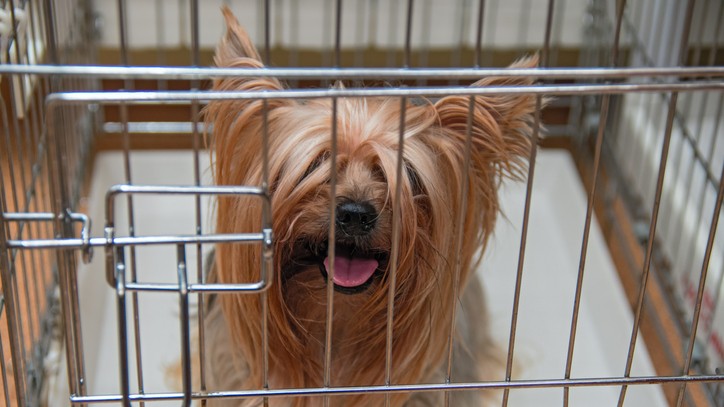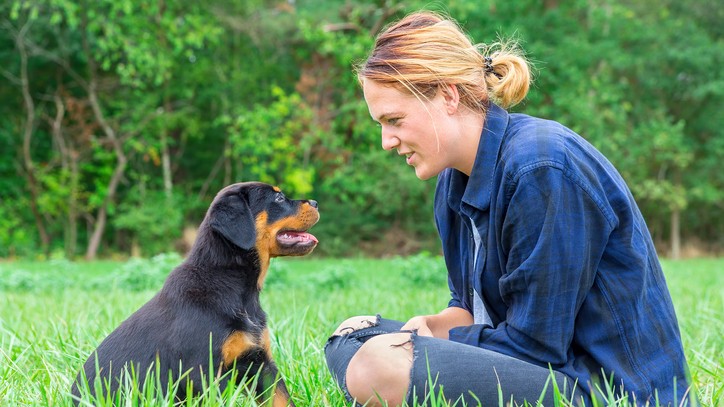Five alternatives to crate training
Does your pup hate being in a crate? Try these alternatives to crate training instead

Looking for alternatives to crate training? While crate training is a brilliant technique, some dogs struggle with being in confined spaces.
Crate training can help to keep your puppy calm, assist with potty training, and even help to keep your puppy safely contained while traveling. More often than not, once your pooch has learned the basics of crate training, many dogs grow to love being in their crate. And who can blame them? It’s their own, dedicated safe space. However, if your dog has had previous bad experiences even with the best dog crates or you feel that your dog is cut off from the rest of the family by being in one, there are a number of alternatives to crate training.
From keeping your puppy tethered to you while keeping your canine companion entertained with some of the best puppy toys, to making use of an exercise pen. According to vet Dr Elizabeth Racine, crate training alternatives like these can stop your puppy from getting into trouble. Here’s what else you can try.

Along with being a freelance writer, Dr. Elizabeth Racine is a small animal general practice veterinarian covering all things pet health and wellness. Dr Racine graduated in 2017 as a Doctor of Veterinary Medicine. She now specializes in veterinary behavior, nutrition, and internal medicine. Dr Racine also works as a freelance writer, writing for major companies in the industry such as the American Kennel Club.
1. Use an exercise pen for your puppy
One of the best alternatives to crate training your puppy is using an exercise pen. Many pet owners are more comfortable with this option because it offers more room for the puppy to move around. An exercise pen also has plenty of space for you to provide the best puppy food, water, bedding, puppy toys, and an appropriate potty surface, meaning all your puppy’s needs can be met in this space! Just like the crate, you will need to do some training with your puppy initially to help them get comfortable with being confined in the exercise pen, especially if they will be in it for long periods of time. However, this is a great option to keep your puppy safe and reduce potty accidents in the house. Just keep in mind that even though the exercise pen is large enough for your puppy to play, they will still need exercise and active play time with you every day to keep them socialized and mentally stimulated!
2. Keep your puppy tethered to you
Another option is to keep your puppy tethered to you using a waist leash or other hands-free system. These products are readily available at pet stores and online. Keeping your puppy tethered to you is a great option, especially during potty training, because it allows you to catch accidents before they happen! If you notice your puppy displaying signs that they need to relieve himself – like circling, sniffing the floor, or posturing – then you can quickly bring him outside and reward them for doing his business in an appropriate place with the best puppy treats. Having your puppy tethered to you also allows you to turn everyday activities into training activities. Try having your puppy lay quietly at your feet while you’re eating, or sit before greeting a family member. Your puppy will learn good manners in no time, because they’ll be practicing with you every day!
3. Use a trailing lead on your puppy
If you prefer not to have your puppy tethered to you, another option is to leave a trailing lead on your puppy while they're in the house. This will allow you to quickly gain control and redirect your puppy if they should happen to get into trouble. However, having a trailing lead on your puppy does have some risks. Your puppy can become tangled around furniture or may be more prone to knocking things over or tripping your family! If you do decide to use a trailing lead on your puppy, you’ll need to take some basic precautions. Look for a nylon training lead without a handle, so your puppy will be less likely to get caught on things. Your puppy should also wear a harness, rather than a neck collar, so that they will not be pulled by his neck if they get caught on something. Finally, make sure you closely supervise your puppy so you can be sure that they are not getting into trouble!

4. Find a pet sitter or doggy daycare
For busy pet owners, an easy alternative to crate training is finding a local pet sitter, doggy day care, or dog walker to take care of your puppy when you are unable to directly supervise them. In addition to getting your puppy out from underfoot, this option has the added benefit of socializing your pup to new people and other dogs! Sitters and day cares can be expensive, but for many pet owners, the peace of mind from knowing their puppy is well cared for is worth the extra cost. Before choosing someone to look after your puppy, check their credentials and have them visit with your puppy in person with you present so you can make sure it’s a good match. If your puppy will be going to day care, ask for a tour of the facility before you sign up. On your tour, pay close attention to the facility and the behavior of the dogs in the day care. Is the space clean and well-maintained? Are the staff cleaning up after the dogs promptly? Do the dogs enjoy interacting with the staff, or do they keep their distance? Is there fresh water available at all times? Are dogs separated based on size and temperament? If the facility looks like a place you’d enjoy spending the day yourself, then it’s probably a good fit for your pup too!
Get the best advice, tips and top tech for your beloved Pets
5. Keep your puppy supervised at all times
This option is by far the most difficult to perform successfully. For families that do not wish to restrict their puppy, keeping the puppy under direct supervision at all times will be necessary. This is easiest to achieve if you have multiple family members who can take turns sharing this task. Remember that keeping your puppy under direct supervision at all times is especially important during potty training – otherwise, you may have accidents in the house, which can prolong the potty training process! You’ll also need to puppy proof your house – such as tucking away cords, covering trash cans, and picking up loose objects – to ensure your puppy doesn’t get into trouble if they slip out of your sight.
Don’t be afraid to use a crate for your dog!
Many pet owners balk at the thought of keeping their dog confined, but with proper training your dog can learn to actually enjoy being in the crate! If you decide not to crate train your puppy, using one of the alternative methods outlined above can help make potty training easier, and can keep your puppy safe and out of trouble.
Looking for more on this? Here’s when to stop crate training and find out more on dealing with separation anxiety: Dog crate solutions pros and cons.
Dr. Elizabeth Racine is a small animal general practice vet covering all things pet health and wellness. Her special interests include veterinary behavior, nutrition, and internal medicine.
As a freelance writer, Dr. Racine has written content for major companies in the industry such as the American Kennel Club, Merck Animal Health, Bayer PetBasics, Elanco, and CareCredit. In her free time, Dr. Racine enjoys playing trampoline dodgeball, hiking with her beagle Dasher, and spending time with her three mischievous cats.
